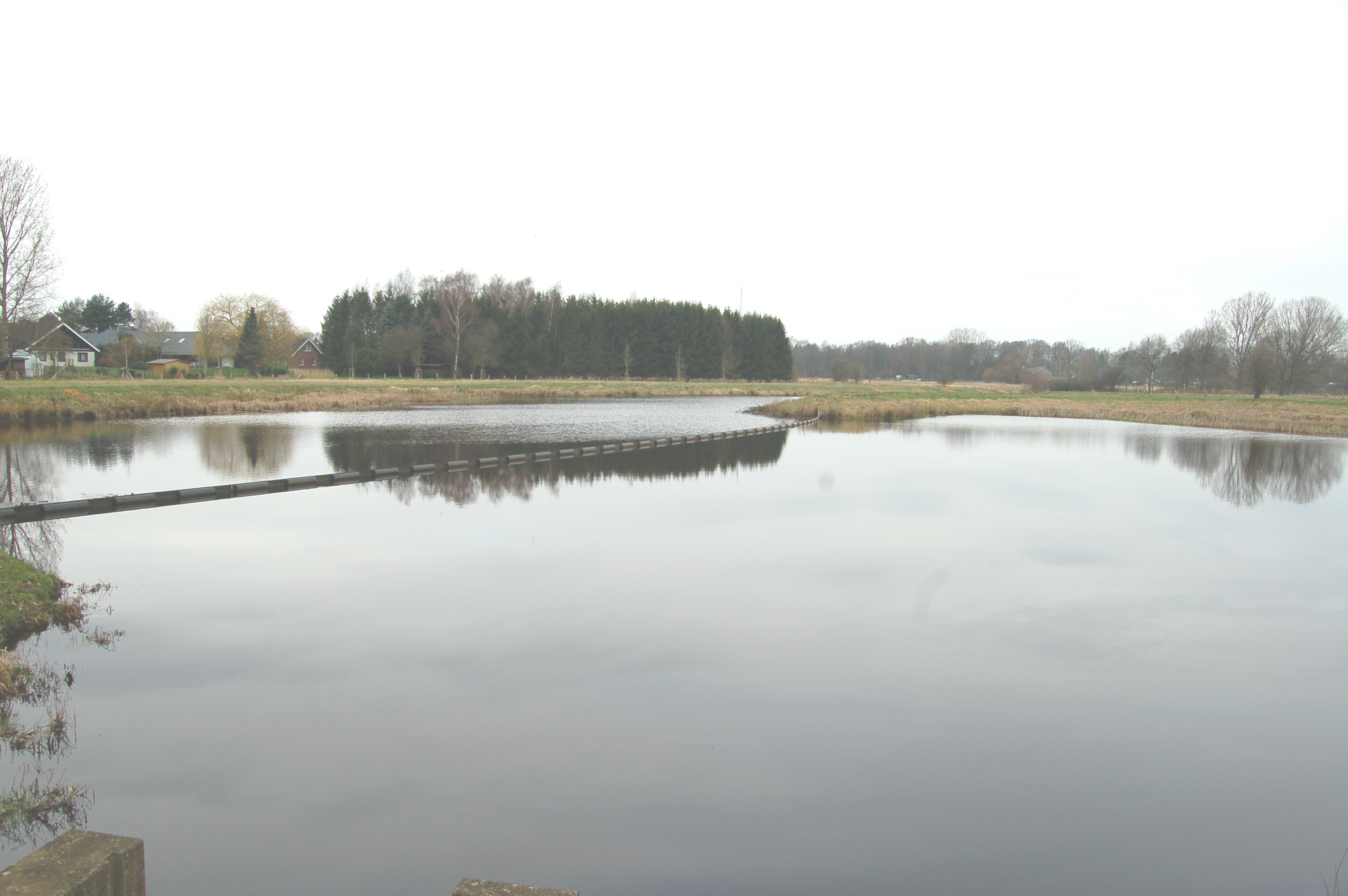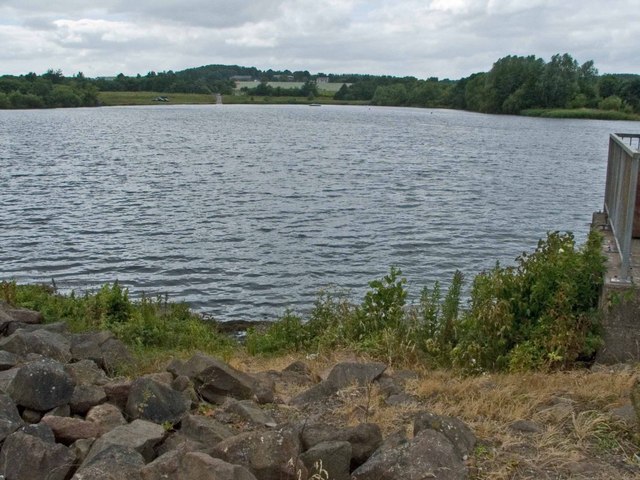|
Retention Basin
A retention basin, sometimes called a retention pond, wet detention basin, or storm water management pond (SWMP), is an artificial pond with vegetation around the perimeter and a permanent pool of water in its design. It is used to manage stormwater runoff, for protection against flooding, for erosion control, and to serve as an artificial wetland and improve the water quality in adjacent bodies of water. It is distinguished from a detention basin, sometimes called a "dry pond", which temporarily stores water after a storm, but eventually empties out at a controlled rate to a downstream water body. It also differs from an infiltration basin which is designed to direct stormwater to groundwater through permeable soils. Wet ponds are frequently used for water quality improvement, groundwater recharge, flood protection, aesthetic improvement, or any combination of these. Sometimes they act as a replacement for the natural absorption of a forest or other natural process ... [...More Info...] [...Related Items...] OR: [Wikipedia] [Google] [Baidu] |
Grass
Poaceae ( ), also called Gramineae ( ), is a large and nearly ubiquitous family (biology), family of monocotyledonous flowering plants commonly known as grasses. It includes the cereal grasses, bamboos, the grasses of natural grassland and species cultivated in lawns and pasture. The latter are commonly referred to collectively as grass. With around 780 genera and around 12,000 species, the Poaceae is the fifth-largest :plant families, plant family, following the Asteraceae, Orchidaceae, Fabaceae and Rubiaceae. The Poaceae are the most economically important plant family, including staple foods from domesticated cereal crops such as maize, wheat, rice, oats, barley, and millet for people and as forage, feed for livestock, meat-producing animals. They provide, through direct human consumption, just over one-half (51%) of all dietary energy; rice provides 20%, wheat supplies 20%, maize (corn) 5.5%, and other grains 6%. Some members of the Poaceae are used as building materials ( ... [...More Info...] [...Related Items...] OR: [Wikipedia] [Google] [Baidu] |
Urban Runoff
Urban runoff is surface runoff of rainwater, landscape irrigation, and car washing created by urbanization. Impervious surfaces (roads, parking lots and sidewalks) are constructed during land development. During rain, storms, and other Precipitation (meteorology), precipitation events, these surfaces (built from materials such as Asphalt concrete, asphalt and concrete), along with rooftops, carry polluted stormwater to storm drains, instead of allowing the water to Infiltration (hydrology), percolate through soil. This causes lowering of the water table (because groundwater recharge is lessened) and flooding since the amount of water that remains on the surface is greater.Water Environment Federation Alexandria, VA; an American Society of Civil ... [...More Info...] [...Related Items...] OR: [Wikipedia] [Google] [Baidu] |
Sustainable Drainage System
Sustainable drainage systems (also known as SuDS,Sustainable Drainage System (SuDs) for Stormwater Management: A Technological and Policy Intervention to Combat Diffuse Pollution Sharma, D., 2008 SUDS, or sustainable urban drainage systems) are a collection of water management practices that aim to align modern Stormwater drain, drainage systems with natural water processes and are part of a larger green infrastructure strategy. SuDS efforts make urban drainage systems more compatible with components of the natural water cycle such as storm surge overflows, soil percolation, and bio-filtrati ... [...More Info...] [...Related Items...] OR: [Wikipedia] [Google] [Baidu] |
Surface Runoff
Surface runoff (also known as overland flow or terrestrial runoff) is the unconfined flow of water over the ground surface, in contrast to ''channel runoff'' (or ''stream flow''). It occurs when excess rainwater, stormwater, meltwater, or other sources, can no longer sufficiently rapidly infiltrate in the soil. This can occur when the soil is #Saturation excess overland flow, saturated by water to its full capacity, and the rain arrives #Infiltration excess overland flow, more quickly than the soil can absorb it. Surface runoff often occurs because wikt:impervious#Adjective, impervious areas (such as roofs and Road surface, pavement) do not allow water to soak into the ground. Furthermore, runoff can occur either through natural or human-made processes. Surface runoff is a major component of the water cycle. It is the primary agent of Soil erosion#Rainfall and runoff, soil erosion by water. The land area producing runoff that drains to a common point is called a drainage basin. ... [...More Info...] [...Related Items...] OR: [Wikipedia] [Google] [Baidu] |
Stream Restoration
Stream restoration or river restoration, also sometimes referred to as river reclamation, is work conducted to improve the environmental health of a river or stream, in support of biodiversity, recreation, flood management and/or landscape development. Stream restoration approaches can be divided into two broad categories: form-based restoration, which relies on physical interventions in a stream to improve its conditions; and process-based restoration, which advocates the restoration of Hydrology, hydrological and Geomorphology, geomorphological processes (such as sediment transport or connectivity between the Channel (geography), channel and the floodplain) to ensure a stream's Ecological resilience, resilience and ecological health. Form-based restoration techniques include deflectors; cross-vanes; weirs, step-pools and other grade-control structures; engineered log jams; bank stabilization methods and other channel-reconfiguration efforts. These induce immediate change in a st ... [...More Info...] [...Related Items...] OR: [Wikipedia] [Google] [Baidu] |
Settling Basin
A settling basin, settling pond or decant pond is an earthen or concrete structure using sedimentation to remove settleable matter and turbidity from wastewater. The basins are used to control water pollution in diverse industries such as agriculture, aquaculture, and mining. Turbidity is an optical property of water caused by scattering of light by material suspended in that water. Although turbidity often varies directly with weight or volumetric measurements of settleable matter, correlation is complicated by variations in size, shape, refractive index, and specific gravity of suspended matter. Settling ponds may be ineffective at reducing turbidity caused by small particles with specific gravity low enough to be suspended by Brownian motion. Applications Settling basins are used as a separation mechanism to eliminate rejected products (i.e. waste solids management strategies) of a specified size and quantity in various fields, such as aquaculture, mining, dairy, food proc ... [...More Info...] [...Related Items...] OR: [Wikipedia] [Google] [Baidu] |
Nationwide Urban Runoff Program
The Nationwide Urban Runoff Program (NURP) was a research project conducted by the United States Environmental Protection Agency (EPA) between 1979 and 1983. It was the first comprehensive study of urban stormwater pollution across the United States. Study objectives The principal focus areas of the study consisted of: * Examine the water quality aspects of urban runoff, and a comparison of results across various urban sites * Assess the impact of urban runoff on overall water quality * Implement stormwater management best practices. A major component of the project was an analysis of water samples collected during 2,300 storms in 28 major metropolitan areas. Findings Among the conclusions of the report are the following: * "Heavy metals (especially copper, lead and zinc) are by far the most prevalent priority pollutant constituents found in urban runoff...Copper is suggested to be the most significant hreat/nowiki> of the three." * "Coliform bacteria are present at high leve ... [...More Info...] [...Related Items...] OR: [Wikipedia] [Google] [Baidu] |
Balancing Lake
A balancing lake (also flood basin ) is a term used in the UK to describe a retention basin used to control flooding by temporarily storing flood waters. The term balancing pond is also used, though typically for smaller storage facilities for streams and brooks. In open countryside, heavy rainfall soaks into the ground and is released relatively slowly into watercourses (ditches, streams, rivers). In an urban area, the extent of hard surfaces (roofs, roads) means that the rainfall is dumped immediately into the drainage system. If left unchecked, this has the potential to cause flooding downstream. The function of a balancing lake as part of a '' sustainable urban drainage scheme'' is to contain this surge and release it slowly. Failure to do this, especially in older settlements without separate storm sewers and foul sewers, can cause serious pollution as well as flooding. Engineering At its simplest, a balancing lake can be constructed by creating a dam across a drain ... [...More Info...] [...Related Items...] OR: [Wikipedia] [Google] [Baidu] |
Urban Fishing
Urban fishing is a type of recreational fishing that takes place in urban areas such as inner cities. The United States Federal Government began urban fishing programs in 1969 during civil unrest in cities throughout the country. It launched the program in six cities, including St. Louis, Missouri, which is one of the largest programs in existence in the U.S. Several states run urban fishing programs where they stock ponds and lakes for anglers. Sewer fishing is a type of urban fishing where angling, anglers attempt to catch fish from storm sewers. Fish wind up in sewers from flooding that takes place from nearby lakes and streams, causing fish to swim to and from the bodies of water. Sewer fishing was documented in the 2018 Nat Geo Wild television series ''Fish My City.'' Risks of urban fishing Pollution in urban waterways produces a risk for fishers when their purpose for fishing is consumption. Throughout multiple rivers in the United States, carcinogens and hazardous chem ... [...More Info...] [...Related Items...] OR: [Wikipedia] [Google] [Baidu] |
Predator
Predation is a biological interaction in which one organism, the predator, kills and eats another organism, its prey. It is one of a family of common List of feeding behaviours, feeding behaviours that includes parasitism and micropredation (which usually do not kill the Host (biology), host) and parasitoidism (which always does, eventually). It is distinct from Scavenger, scavenging on dead prey, though many predators also scavenge; it overlaps with Herbivore, herbivory, as Seed predation, seed predators and destructive frugivores are predators. Predation behavior varies significantly depending on the organism. Many predators, especially carnivores, have evolved distinct hunting strategy, hunting strategies. Pursuit predation involves the active search for and pursuit of prey, whilst ambush predation, ambush predators instead wait for prey to present an opportunity for capture, and often use stealth or aggressive mimicry. Other predators are opportunism, opportunistic or om ... [...More Info...] [...Related Items...] OR: [Wikipedia] [Google] [Baidu] |
Coyote
The coyote (''Canis latrans''), also known as the American jackal, prairie wolf, or brush wolf, is a species of canis, canine native to North America. It is smaller than its close relative, the Wolf, gray wolf, and slightly smaller than the closely related eastern wolf and red wolf. It fills much of the same ecological niche as the golden jackal does in Eurasia; however, the coyote is generally larger. The coyote is listed as Least Concern, least concern by the International Union for Conservation of Nature, due to its wide distribution and abundance throughout North America. The species is versatile, able to adapt to and expand into environments modified by humans; urban coyotes are common in many cities. The coyote was sighted in eastern Panama (across the Panama Canal from their home range) for the first time in 2013. The coyote has 19 recognized subspecies. The average male weighs and the average female . Their fur color is predominantly light gray and red or fulvous int ... [...More Info...] [...Related Items...] OR: [Wikipedia] [Google] [Baidu] |






